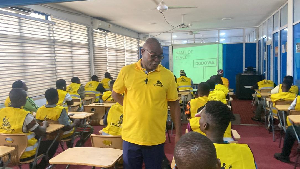WITH THE situation at Akosombo far from improving, the fragile Ghanaian economy faces uncertain future as many industries cry over their inability to achieve targets.
From hairdressers to mining companies, the mantra is that the VRA/Electricity Company of Ghana (ECG) power rationing is ‘killing our businesses’.
At Tema, the rejuvenated VALCO owned 90% by the Ghana Government is operating at 25% capacity following its reduction of power consumption by 35%.
According to the Director of Human Resources, the company was operating on 200 pot lines with production at 40% capacity but with the cut, it is now operating on 150 pot lines with a production capacity of 30%.
AngloGold Ashanti says it will shut its Iduapriem mine and stand to shed 10% of its September quarter output at Obuasi, its key Ghanaian gold mine, if power restrictions remain in place or worsen, the company said in a statement issued on Wednesday.
“ If AngloGold Ashanti has to reduce power consumption by more than the current 25%, it is likely that the company’s opencast Iduapriem mine would be closed because the remaining mill would have to be stopped,” it warned.
As it stands, if the 25% power reduction remains in place at Iduapriem for the rest of the month, production could be 30% lower for the quarter. The mine was expected to produce 52,000 oz in the third quarter. AngloGold Ashanti, the world’s number three gold producer, is struggling to successfully turn around its under-performing Ghana mines - Obuasi in particular - since buying the Ashanti Goldfields assets for $1.2bn in 2004.
A water shortage at the Volta River Authority’s (VRA) power generation facilities have meant gold mining companies, amongst the largest users of electricity in the West African country, have been told to cut back their use of electricity from the national grid for an unspecified period of time.
While Obuasi is using 25% less electricity with no immediate impact on production, if it has to continue to do so for the remainder of September, gold production will fall to 90,000 oz, some 10,000 oz lower than forecast for the three months ending September. AngloGold Ashanti is hardest hit than other mining companies because they have underground operations.
“If you take what’s happening in Ghana in total the context, AngloGold Ashanti ’s production is very, very small. But for the operations themselves, it will make a difference.
It is difficult to forecast just how long this is going to last, but it’s not the end of the world for the company,” observed a mining analyst. AngloGold Ashanti produced 1.4million oz of gold in the June quarter at a total cash cost of $305/oz. Obuasi is using older standby diesel-powered generators to provide electricity for its operations at a cost of $1.8m for the month. This would add an extra $60/oz to the cost of producing gold at the deep-level, multi-shaft mine. In the June quarter, Obuasi had total cash costs of $406/oz.
‘This is not a sustainable solution due to the unreliability of the generator and the risks associated with reliance on deliveries of diesel fuel by road transport,” AngloGold Ashanti said.
“In the event that a significantly higher cut in power became necessary, it would result in a substantial loss in gold production,” it added.
There is no indication of when the power shortage will come to an end, but AngloGold Ashanti spokesman Charles Carter said water levels in the Akosombo Dam are beginning to rise.
. “For now it looks manageable, but it’s unpredictable in terms of the timeline,” Carter said. “If the rains come, this issue goes away quite quickly. If it hey doesn’t we’ll have to re-guide the market,” he said.
At the Wassa area in Western Region, Gold Fields’ opencast Damang mine is completely off the national grid because the company has brought in generators to provide the 56,000/oz a quarter mine and mills with sufficient power, said spokesman Willie Jacobsz. “It should not affect production but it will impact costs at Damang,” he said. Damang had total cash costs of $315/oz in the June quarter.
Operating costs are expected to rise by $4m if the power generation needs to be continued for a full month. Gold Fields said at the end of August, its Ghana subsidiary had been told by the VRA to reduce power consumption at its operations by half.
“We are freeing up grid power from Damang and re-allocating all our grid power to Tarkwa, so Tarkwa will be entirely on the grid,” he said. Tarkwa, an opencast mine, produced 176,000 oz in the June quarter at a total cash cost of $321/oz.
Ghana provided just over 20% of Gold Fields’ 1.02m oz of gold production in the June quarter.
Golden Star, which operates the Prestea and Bogoso mines, and Australia ’s Chirano Gold Mine, have all been forced to cut their power usage by VRA/ECG. “We have constructed a new multimillion dollar BIOX plant but there is no power to put it on steam”, an official of Golden Star complained.
AngloGold Ashanti, Gold Fields and Newmont Mining, which started production at its Ahafo mine in Ghana in July, are working through the Chamber of Mines to resolve the power constraints.
The mines are providing management support and helping repair the thermal unit at the Aboadze plant in Takoradi. The Ahafo mine is expected to produce 550,000 oz/year at full tilt, according to the Denver firm’s annual report. Newmont is also developing the Akyem project due to begin production in 2008.
















